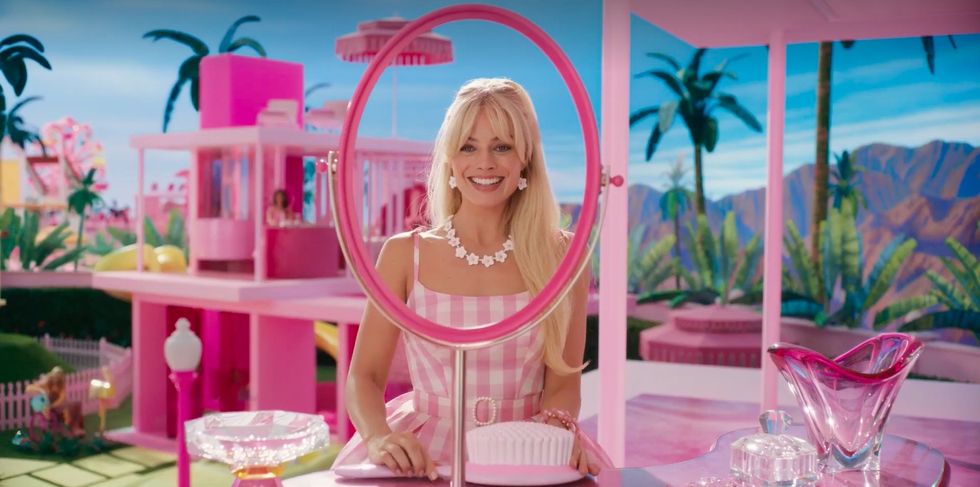If you scroll through the internet today, turn on your TV, or even just open your eyes, you cannot escape Barbie. This 11 inch-high plastic doll, first moulded in 1959, has taken over the zeitgeist for what feels like an entire summer, thanks to Greta Gerwig's much-hyped Barbie film, starring Margot Robbie. Even the man who created the atomic bomb, as depicted in Christopher Nolan's Oppenheimer, is playing second fiddle to a child’s toy. What's also impossible to escape is the swirling mass of discussion about the moral and social significance of this character. And no, I don't mean the man who created one of our most potent and threatening weapons of war – I mean the Barbie doll.
Why is it that we hound this doll and naval gaze endlessly about her impact and legacy? After all, Action Man and even Ken do not court as much controversy as Barbie. While they remain largely unchallenged toys, Barbie is a lightning rod for the messy, knotty contradictions of feminism, sexism, misogyny and body image. The answer, of course, is that Barbie may be just a doll, but she is still a woman – and even as a pretend female, her life, her choices and her body are just as policed.
The instantly revolutionary thing about Barbie, when she first arrived in 1959, was that she wasn’t a baby. Dolls in a pre-Barbie age were babies for children; essentially a means by which young girls would play at adulthood by actually playing at motherhood. Barbie’s radical move was to be a fully-grown woman onto whom young girls could project ideas of selfhood. Problematic proportions aside, she was still a grown-up with whom girls could act out dreams of adult life that did not necessitate having children. As Barbie’s remit has grown, allowing her to be anything from a doctor to President, so she remains a conduit for the dreams of young girls (and boys), with an ever-expanding portfolio of what she – and, by extension, they – can be. Happily, post 2016, she can also be ‘plus size’.
The story of Barbie is in many ways, the story of women. When she was initially conceived, she was expected to aspire to nothing more than marrying Ken. The original TV spot for Barbie includes a saccharine song which praises her fashion sense and lets the camera pan longingly over a doll in a wedding dress – the zenith of female achievement indeed. But as mores altered, so did Barbie’s.
She is now expected to run for president (since the first ‘President Barbie’ doll in 1992 she has never not campaigned in a Presidential race), be an entrepreneur, a fighter pilot, a surgeon, a vet, a pop star, a dancer, a professor and do it all in heels, all whilst defending herself against not having children or being a bimbo for having blonde hair and large breasts. The dream of this doll as a tool for female self-actualisation has come true in more ways than one. At some point, every woman has been Barbie.
Indeed, Barbie can be seen as an avatar for the journey of women over the last sixty-four years. She has always reflected her times, from the arrival of the first Black doll at Mattel, Christie, the same year as the Civil Rights At in 1968; to mirroring the expansion of the female workforce in the 1980s, with the first corporate working Barbie. She may not be quite the radical forerunner we all hope she could be – a tardy follower, perhaps, more than a pioneer – but she nonetheless strives to reflect the age. And in so doing, she reflects more than just the socio-economic politics of her day, but becomes a repository for contemporaneous views of women – by both women and society at large.
Of course, as with real-life women, the way Barbie looks is often scrutinised. She may be a Marine or a hairdresser, but the commentary surrounding her will always go back to her appearance. In many ways, this is useful and necessary feedback. Why, after all, did it take so long to have a Barbie in a wheelchair, or a Barbie with Downs Syndrome? Why has Barbie been so nightmarishly proportioned for so long? It was not until 2016 (57 years after her creation) that Barbie’s body shape changed in any real way. Indeed, why doesn’t she have flat feet, for starters? And why, despite Mattel’s best efforts, is she still importunately viewed as Caucasian? After all, it is no coincidence that, while Issa Rae, Alexandra Shipp and Ritu Arya are all ‘Barbie’ in the new film, it is Margot Robbie who is viewed as the real deal.
So, in this way, Barbie, for all her preposterous dimensions, is an everywoman. She is doing too much, or not enough; she is too pretty, or not pretty enough; she works too much, or not enough; she is too skinny, or too ‘plus size.’ She is a bimbo for having big boobs and blonde hair; she is an anti-feminist for liking fashion and wearing high heels. Barbie was designed as a way for girls to project ideas of their own adulthood, but she is equally a battering ram to their self-esteem, with her own daunting bodily proportions and less than representative models.
Whether she is feminist or not is actually neither here nor there. What is more intriguing is the fact that a female doll can never just be a plaything, but must be some grand emblem for the prospects and expectations of women. Ken really is just Ken, and Barbie – for better or worse – is everything.








